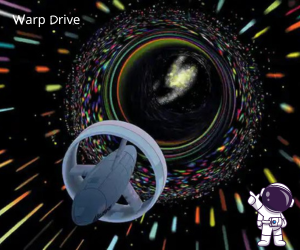Introduction:
As a dedicated fan of Star Trek, I understand the profound impact the concept of warp drive has had on the series and its viewers. Warp drive, often associated with the Star Trek universe, is a fictional superluminal spacecraft propulsion system that enables faster-than-light travel. Let’s delve into the origins of warp drive and its journey from the pages of science fiction to ongoing physics research.
Since the advent of Star Trek, the popular science fiction series has inspired countless scientific inquiries and technological developments. Among the fascinating concepts explored in the show, warp drive stands out as a theoretical mode of faster-than-light (FTL) travel. This article delves into the concept of warp drive, its historical origins, the Alcubierre drive, and ongoing research efforts to bridge the gap between fiction and reality.

Warp Drive device that could transport a starship at the enormous speed faster than light.
Origins of Warp Drive:
Warp drive was first introduced in the fictional world of Star Trek, allowing spaceships to surpass the speed of light and traverse the vastness of the galaxy. While initially a creation of science fiction, warp drive captured the imagination of both viewers and scientists alike, leading to the exploration of its theoretical feasibility. The general concept of warp drive was first introduced by John W. Campbell in his 1957 novel, “Islands of Space.” Campbell’s novel popularized the idea of a propulsion system capable of surpassing the speed of light, allowing spaceships to traverse vast distances within the cosmos. This marked the initial emergence of warp drive in the realm of science fiction.
While warp drive gained recognition through Campbell’s work, it was Star Trek that brought this concept to the forefront of popular culture. The iconic science fiction series, created by Gene Roddenberry, prominently featured warp drive as the primary method of interstellar travel for the starships in the show. Star Trek’s portrayal of warp drive captured the imagination of millions, leading to its association with the franchise and its dedicated fanbase.
The Alcubierre Drive:
Mexican physicist Miguel Alcubierre proposed the concept of the Alcubierre drive in 1994. This innovative theory involves creating a “bubble” in space-time, which would contract space ahead of the spacecraft and expand it behind, enabling faster-than-light travel within the bubble. While skepticism surrounded the practicality of Alcubierre’s warp drive, mathematical possibilities were highlighted by Joseph Agnew, a University of Alabama undergraduate student, who emphasized that fulfilling all energy requirements would make it mathematically plausible.
Challenges and Limitations:
Einstein’s Theory of Relativity poses significant challenges to the realization of warp drive. According to this theory, surpassing the speed of light is impossible, and as an object’s speed increases, its mass also increases, making acceleration increasingly difficult. These fundamental limitations present hurdles that need to be overcome to achieve warp drive technology.
Manipulating Space-Time:
Exploring the manipulation of space-time and investigating new insights into general relativity may lead to breakthroughs in propulsion technology. Researchers are continuously working to refine our understanding of these fundamental concepts and seeking innovative ways to overcome the challenges associated with faster-than-light travel.
Mass-Energy Requirements:
One major obstacle to realizing warp drive is the enormous mass-energy requirements. Alcubierre’s original proposal suggested that a mass equivalent to that of Jupiter would be necessary, posing astronomical energy demands that exceed the resources of the universe itself. However, NASA engineer and physicist Dr. Harold ‘Sonny’ White has been researching ways to reduce the mass-energy requirement. White’s exploration of altering the shape of the negative mass ring holds the potential to bring the requirement down to a more manageable 700kg.
Current Research and Future Prospects:
Dr. White is currently leading a team of esteemed physicists and engineers at NASA, working on the White-Juday Warp Field Interferometer. This cutting-edge device, capable of detecting and generating small warp bubbles, represents a significant step towards the development of functional warp drive technology. While interstellar travel and functional warp drives remain a distant horizon, the continuous advancements in technology hint at a future where these once-fictional concepts may become a reality.
Conclusion:
Warp drive, a groundbreaking concept introduced by Star Trek, has transcended the realm of science fiction and has become a subject of serious scientific inquiry. The theoretical framework proposed by Miguel Alcubierre and ongoing research efforts led by Dr. Harold White at NASA demonstrate the commitment to exploring the boundaries of our understanding and pushing the limits of technological innovation. While challenges remain, the pursuit of warp drive technology brings us closer to realizing humanity’s dream of interstellar exploration and reaching destinations beyond our current reach.

